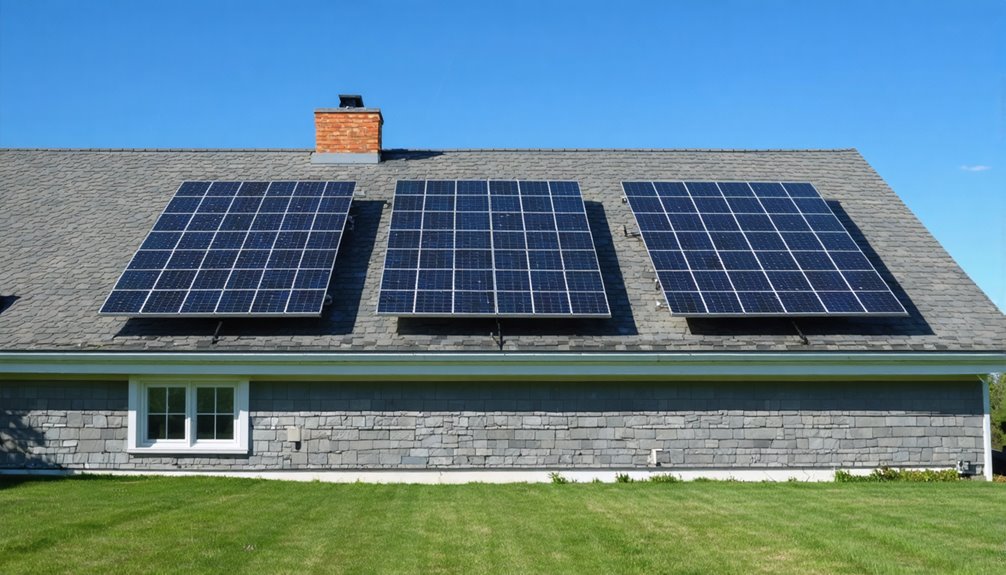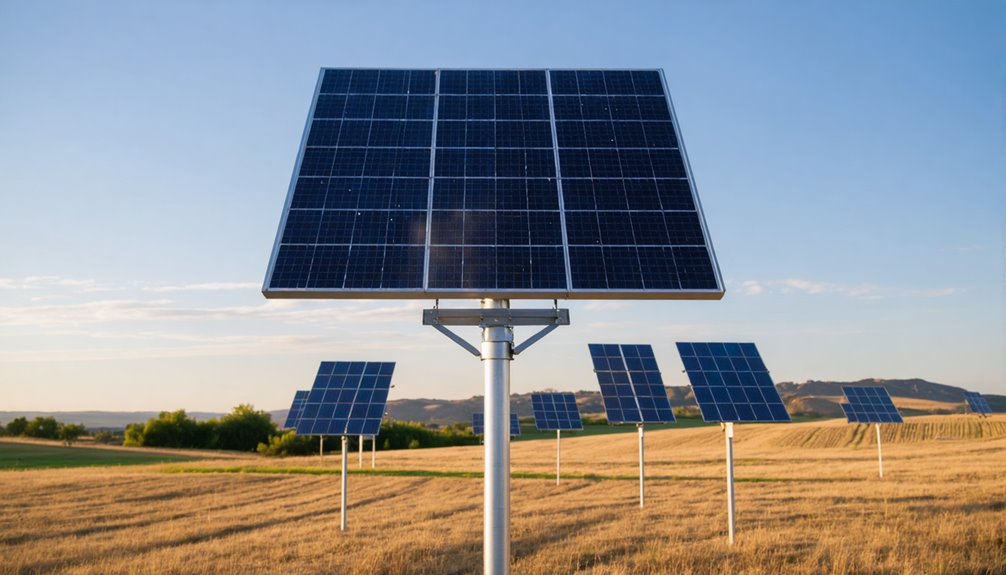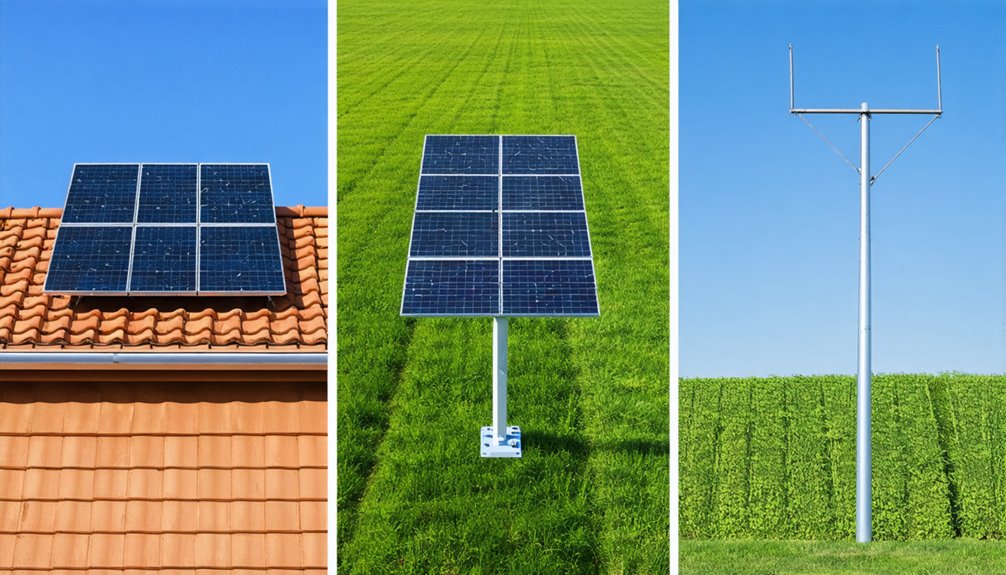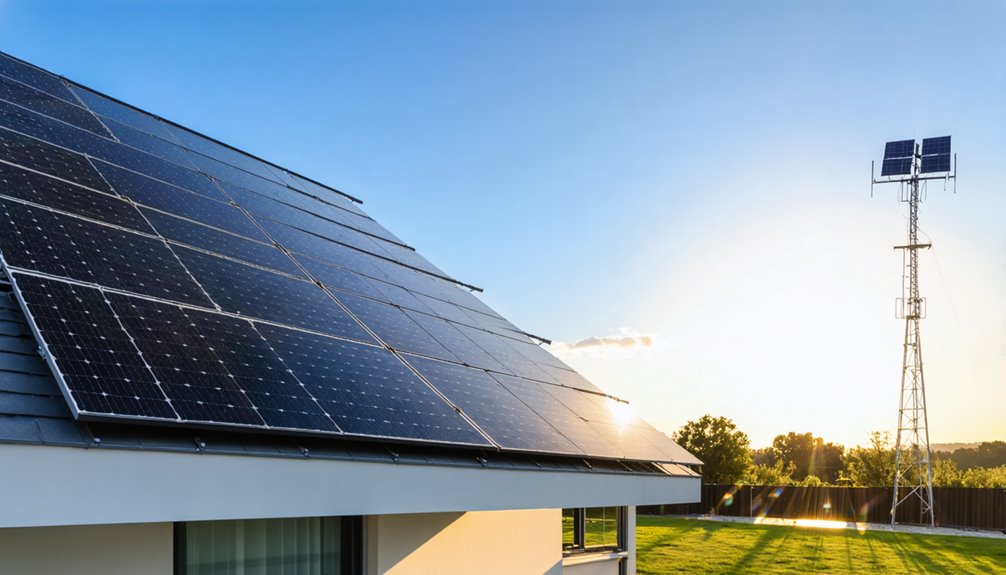You’re seeing more solar panels pop up in neighborhoods across America. But here’s what most people don’t realize – the mounting system you choose can make or break your solar investment. Whether it’s on your roof, standing in your yard, or perched on a pole, each mount type affects how much power you’ll generate. The differences between these options might surprise you.
Types of Solar Panel Mounting Systems Available

Solar panel mounting systems come in several different types, each built for specific locations and needs. You’ll find four main options when shopping for mounts.
Roof mounts fit directly on your home’s roof. They’re popular because they don’t take up yard space. These systems work on flat or sloped roofs and come with different attachment methods.
Ground mounts sit in your yard on metal frames. They’re perfect if you’ve got extra land. You can choose fixed or adjustable versions. Ground-mounted systems often feature adjustable tilt capabilities to maximize sun exposure throughout different seasons.
Pole mounts stack multiple panels on one tall post. They save space and some can track the sun’s movement throughout the day.
Carport mounts do double duty. They create covered parking while generating electricity overhead. You’ll see these at homes and businesses.
Roof Mount Solar Systems: Features and Benefits
You’ll find roof mount solar systems work with many different roof types, from regular shingles to Spanish tiles and metal standing seam roofs. These systems now include zero penetration mounting options that won’t create holes in your roof, protecting against leaks while meeting strict engineering standards. For flat commercial roofs, ballast mount systems provide a weighted solution that secures panels without any roof penetration, making them ideal for businesses concerned about maintaining their roof warranty. The mounting hardware’s been tested to handle heavy winds and snow loads, ensuring your panels stay secure through tough weather conditions.
Roof Compatibility Options
Three main roofing types work well with solar panel mounts: composition shingles, Spanish tile, and standing seam metal. These roof compatibility options make roof mount solar systems accessible to most homeowners.
You’ll find that modern mounting systems adapt to different roofing materials without compromising performance. Each type requires specific hardware, but manufacturers have developed solutions for nearly every roof style.
Zero roof penetration mounts offer extra protection for your home. They secure panels without drilling holes through your roof’s surface. This technology reduces leak risks while keeping panels firmly in place.
Most mounting systems come with stamped engineering certifications. These documents prove the mounts meet safety standards and won’t damage your roof’s structure. The engineering stamps also confirm that the systems can handle wind and weather conditions.
Zero Penetration Technology
When homeowners want solar panels but worry about roof damage, zero penetration technology offers a solution that doesn’t require drilling holes. Zero penetration roof mounts use engineering methods to secure solar panel mounts without breaking through the roof’s surface.
These systems spread weight across the roof, which protects roof integrity while keeping panels stable. They work on flat and sloped roofs. Users can adjust the tilt to catch more sunlight.
The technology cuts down installation time since workers don’t need to drill or seal holes. This also means lower costs. Many manufacturers back their products with warranties.
Without holes in the roof, there’s no risk of leaks. Homeowners won’t need extra maintenance to check for water damage around mounting points.
Engineering Support Standards
Professional engineers review roof mount solar systems before installation to make sure they’re safe and follow local building codes. This engineering support includes stamped documentation that confirms the design meets all requirements.
Engineers check your roof’s condition and structure before approving any installation. They’ll examine the orientation and strength to determine if it can support high-quality solar panels. Most roof mount systems come with this professional review as a standard feature.
The engineering assessment covers different roofing materials too. Whether you’ve got shingles, tiles, or metal roofing, engineers verify that the mounting system will work properly. This support helps prevent problems later. It’s especially important for zero-penetration mounts, which need careful planning to stay secure without drilling holes.
Ground Mount Solar Systems: Installation and Advantages
You’ll need to prepare your site before installing ground mount solar systems, which includes checking soil conditions and clearing the area of obstacles. The installation process involves several steps, from anchoring the frames into the ground to connecting the electrical components. Ground mount systems offer optimal tilt angles that can be adjusted seasonally to maximize energy production throughout the year. When you compare costs and benefits, you’re looking at factors like the extra expense of concrete bases versus the easier maintenance access these systems provide.
Site Preparation Requirements
Before installing ground mount solar systems, property owners need to prepare their sites properly to ascertain safe and effective installations. You’ll find that site preparation involves several critical steps. First, contractors assess soil conditions to confirm the ground can support the system’s weight. They’ll also check local zoning regulations that might affect where you can place panels.
| Preparation Step | Purpose | Key Consideration |
|---|---|---|
| Soil Assessment | Stability Testing | Weight Support |
| Zoning Review | Legal Compliance | Placement Rules |
| Area Selection | Maximum Exposure | No Tree Shadows |
Ground mounting requires open spaces without trees or buildings that block sunlight. You’ll need trenching for electrical connections, which adds to costs. The good news? These systems offer easier maintenance access than roof installations.
Installation Process Steps
After preparing the site, contractors typically start the ground mount installation by digging holes for concrete footings or preparing level surfaces for ballasted systems. They’ll secure the solar mounting and racking structures to these bases. Workers then attach metal frames at specific angles to maximize sun exposure.
Next, they’ll install solar panels onto the mounting framework. Ground-mounted solar systems offer various mounting options depending on your property’s needs. Crews connect electrical wiring from panels to inverters and your home’s electrical system. They’ll often need to dig trenches for underground cables.
The entire process usually takes two to five days. Installation costs make up about 10% of your total system expense. These ground mounts let you position panels perfectly without roof limitations.
Cost Benefit Analysis
Ground-mounted solar systems can save you money in the long run, especially when you’ve got plenty of open space on your property. The cost benefit analysis shows these solar mounting solutions offer flexibility that roof mounts can’t match.
Installing solar on the ground costs about $18,000 for a 6kW system. That’s roughly $3 per watt. You’ll find ground-mounted solar systems easier to maintain and adjust for maximum sun exposure.
| Feature | Ground Mount | Roof Mount |
|---|---|---|
| Installation Cost | $3/watt | $2.50-3.50/watt |
| Maintenance Access | Easy | Difficult |
| Shading Issues | Minimal | Common |
| Tilt Adjustment | Yes | Limited |
| Property Requirements | Open land | Suitable roof |
Fixed mounts cost less than adjustable ones. Ballasted systems don’t need digging but they’re pricier upfront. The reduced shading means you’ll generate more energy year-round.
Pole Mount Solar Systems: Design and Applications

Three key features make pole mount solar systems stand out from other mounting options. First, they’re elevated structures that let you use the space underneath for parking or storage. Second, these mounting solutions can support multiple panels on a single pole, maximizing your solar installation’s efficiency. Third, they often include tracking features that follow the sun throughout the day.
Pole mount systems can boost solar energy output by up to 35% when equipped with sun tracking technology. They’re designed to fit various pole diameters, typically between 3 to 4 inches, and work with different panel sizes, including 30W models. The elevated design keeps panels clear of ground debris and improves airflow. These systems demonstrate superior durability in weather conditions compared to roof-mounted alternatives, making them ideal for harsh climates. While the sturdy foundations required for installation may increase upfront costs, these systems offer flexibility for various site conditions.
Solar Carport Mounting Solutions for Commercial and Residential Use
When you’re looking for a mounting solution that serves double duty, solar carports offer both covered parking and clean energy production. These structures work well for residential driveways and commercial parking lots.
Pre-made solar carport systems come in different sizes. You can customize them to fit your specific site. They’re designed to handle large-scale projects while disturbing the ground minimally.
Many mounting solutions include built-in shade features. These reduce heat and glare in parking areas. The structures also look good while generating power.
Solar carports connect easily to existing electrical systems. This means you’ll see energy savings right away. Both homeowners and businesses use these versatile mounting systems. They maximize space usage while creating renewable energy. The dual-purpose design makes them increasingly popular nationwide. Incorporating adjustable panel angles into carport designs can boost solar output by up to 25%, maximizing energy capture throughout changing seasons.
Key Components and Materials in Solar Mounting Systems
Every solar mounting system relies on specific parts working together to hold panels securely in place. You’ll find mounting brackets and clamps that connect panels to the solar racking rails. These rails come in aluminum or stainless steel, which are durable materials that resist rust and weather damage.
Roof attachments use special fasteners with flashing seals. This design stops water from leaking into your home. The clamps adjust to fit different panel sizes and angles, helping capture more sunlight.
Some newer systems don’t use rails at all. These railless options create a cleaner look while staying strong. All components must meet strict standards for wind and snow loads in your area. Professional mounting systems use corrosion-resistant materials that have been tested to withstand various weather conditions and environmental challenges.
Cost Comparison of Different Solar Mount Types

The cost of solar mounting systems varies widely based on the type you choose. Your mounting structure typically represents about 10% of your total installation budget. For a $10,000 solar system, you’ll spend around $1,000 on mounts.
| Mount Type | Base Cost | Additional Expenses |
|---|---|---|
| Roof Mounts | Most affordable | Complex roofs increase price |
| Ground Mounts | Moderate pricing | Trenching and concrete add costs |
| Pole Mounts | Higher upfront | Foundation work required |
Roof mounts remain the cheapest option since they’re attached to existing structures. Ground mounts offer reasonable prices for open land installations. Pole mounts cost more initially but save space. Solar tracking systems add $0.50 to $2.00 per watt to any mount type, though they can boost energy production considerably. When paired with high-efficiency panels like the Jinko Tiger Neo or Trina Vertex models, the right mounting system maximizes your return on investment.
Installation Requirements and Permitting Considerations
Before you install solar panel mounts, you’ll need proper permits from your local government. Local permitting rules differ across regions, so you’ll have to check your area’s specific requirements.
Installation requirements vary based on your mount type and home layout. Ground and pole mounts often need trenching or concrete bases. Steep roofs require extra safety measures and labor. Some systems need engineered approvals or city inspections, especially larger or unique setups.
Licensed professionals can help you navigate these permitting considerations. They understand building codes and zoning regulations in your area. They’ll guarantee your installation meets all requirements.
Site assessments might be necessary for certain installations. These evaluations determine if your property can support the planned solar system. Different roof types present unique challenges that can impact the mounting system selection and installation approach. The complexity of these requirements can affect your project timeline and costs.
Top Solar Mount Manufacturers and Brand Recommendations
When you’re shopping for solar panel mounts, several top manufacturers dominate the market with proven products. IronRidge’s XR rail series handles tough weather on pitched roofs. These mounting products last for years in rain, snow, and wind.
Unirac makes flat rooftop solar equipment with adjustable tilts. You can change the angle without depending on your roof’s slope. Tamarack Solar creates custom mounts for ground setups and solar panel pole installations. They’ll work with different project needs.
SunModo offers budget-friendly clamp kits that fit many configurations. Their solar equipment costs less than other brands.
Each manufacturer uses different technology and pricing. Some brands work better with certain panel models. Local rules might affect which mounting products you can use.
Conclusion
You’ve got three main choices for mounting solar panels. Roof mounts work best when you’re short on yard space. Ground mounts let you adjust the panels’ angle throughout the year. Pole mounts lift panels high and can turn to follow the sun. Each type works differently and costs different amounts. The right choice depends on your property’s layout and what you’re trying to achieve with solar power.


